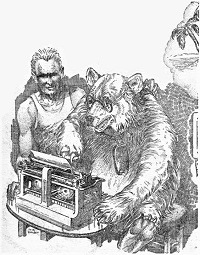Plot summary
Johnny Black is an American black bear, an experimental animal under the care of Professor Methuen at a biological station near the town of Frederiksted on the island of St. Croix in the U.S. Virgin Islands. He has been injected with "a chemical that lowered the resistance of the synapses between his brain cells, making that complicated process called 'thought' about as easy for Johnny's little brain as a man's big one."
At the beginning of the story, hoping to learn more about the science to which he owes his human intelligence, Johnny is reading an encyclopedia article about chemistry. Finding it hard to puzzle through without Professor Methuen's help, he goes for an amble about the station. The station seems unusually quiet. At the cages housing some of the other animals he finds the birds and monkeys chattering away as usual, but the chimpanzee McGinty in a catatonic state. Trotting over to the kitchen in hope of lunch, he finds the cook Honoria Velez in the same condition, and afterwards the station's scientists, including his patron Methuen, equally afflicted. Only nipping or prodding at them induces them into any movement, and that the minimum required to avoid the stimulus.
The only activity Johnny observes in the vicinity is a number of balloons floating up from the laboratory of Bemis, a botanist unpopular among the other biologists. Investigating, he discovers two strange men inflating and releasing the balloons. As part of an experiment of Bemis's, the balloons carry mold samples into the stratosphere to determine the mutational effects on them of cosmic rays. Johnny attempts to greet the men but is shot at and flees. Later, helping himself to some food back at the kitchen, he hears the strangers drive up. He hides as they order Honoria to load supplies into their truck, a demand with which she complies as if hypnotized. The two return to Bemis's with Johnny secretly following, where they meet two other men, one of them Bemis himself. Johnny decides Bemis must be behind whatever is going on. Eavesdropping confirms this: it is one of the botanist's mutated molds, with will-inhibiting effects specific to higher anthropoids, that has afflicted the biological station. Moreover, its influence is spreading. Bemis expects the whole Earth to be affected within a few weeks, whereupon he and his henchmen will take over the world.
After the conspirators part to attend to various errands, Johnny waylays and kills them separately, then breaks into Bemis's desk in search of the antidote he reasons they must have possessed. He discovers a bottle of potassium iodide, a standard fungicide, and two hypodermic syringes. Clumsily, with teeth and claws, he manages to open the bottle and fill one of the syringes, with which he trots back to the station in search of Methuen. But his attempts to inject Methuen and the other victims fail, as they instinctively resist his efforts. Nor can he order them to do it themselves, as the conspirators might have, his ursine mouth and throat being incapable of human speech. Attempting to direct them via sign language or a laboriously typed message fare no better. Johnny is frustrated: "It seemed absurd–even his little bear's sense of humor realized that–that the spell could be broken by a simple command, that he alone in the whole world knew the command, and that he had no way of giving it."
Finally he has an idea; using the record collection and recording device of one of the scientists, he isolates and re-records the phrase "Now look here!" – which he plays to Methuen, forcing his mentor to pay attention to the message he had previously typed: "PICK UP SIRINGE AND INJECT SOLUTION INTO YOUR UPPER ARM." After reading the message Methuen complies, and gradually emerges from his trance. Afterwards the two of them return to the typewriter, on which Johnny slowly taps out his account of what has happened. Methuen is amazed – "Think of it, Johnny, a bear saving the world!" – and effusively grateful. But any reward will have to wait. First there are the rest of the scientists and people of St. Croix to cure, and then the population of the rest of the Caribbean islands and the mainland.
A week later, beset by boredom in the now mostly-deserted biological station, Johnny attempts the chemistry article once more, still with no one available to help him through the difficult parts.
Literary significance and criticism
"The Command" is one of de Camp's earliest works of fiction, and, together with its successors "The Incorrigible," "The Emancipated" and "The Exalted," it represents his first effort to construct a connected series. Regarding it, de Camp has written "'The Command' had no special inspiration, unless one counts visits to the Central Park Zoo. It was the first of a series of four sequels. I learned the hard way that each story of a series must top its predecessor or it will look less good. In this case, the series ran down; Johnny Black starts out by saving the world and ends up saving his boss's job. It should have been the other way around, but that would have meant planning the whole series in advance. This would have been wise, but I did not then know that." [2]
In the analysis of science fiction historians Alexei and Cory Panshin, the story typified an attitude of de Camp remarkable for the genre of the time: "In the proto-ecological universe projected by de Camp, to be human ... was a natural state of being which we might share with a wide variety of creatures. ... [D]e Camp was capable of imagining what previously would have been thought of as lesser beings–[such as] a black bear experimentally raised to high intelligence in 'The Command' (Astounding, Oct. 1939) ... as being as decent, rational and civilized as most men manage to be, and maybe even more so." [5]

The Hand of Zei is a science fiction novel by American writer L. Sprague de Camp, the second book of his Viagens Interplanetarias series and its subseries of stories set on the fictional planet Krishna. The book has a convoluted publication history.

The Best of L. Sprague de Camp is a collection of writings by American science fiction and fantasy author L. Sprague de Camp, first published in hardback by Nelson Doubleday in February 1978 and in paperback by Ballantine Books in May of the same year. The book was reprinted by Ballantine in May 1986. It was reissued in trade paperback and ebook editions by Phoenix Pick in December 2014. It has also been translated into German.

Sprague de Camp's New Anthology of Science Fiction is a collection of science fiction stories by American writer L. Sprague de Camp, edited by H. J. Campbell. It was first published in both hardcover and paperback in 1953 by Panther Books.
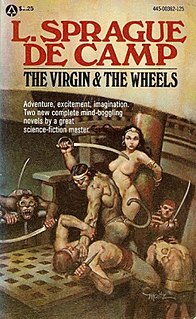
The Virgin & the Wheels is a collection of two short science fiction novels by L. Sprague de Camp, published in paperback by Popular Library in 1976. An E-book edition was published by Gollancz's SF Gateway imprint on September 29, 2011 as part of a general release of de Camp's works in electronic form.
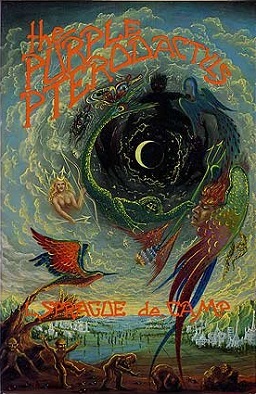
The Purple Pterodactyls is a collection of fantasy short stories by American writer L. Sprague de Camp. The collection was first published in hardcover by Phantasia Press in January, 1980, and in paperback by Ace Books in April of the same year. It has also been translated into German. An e-book edition was published by Gollancz's SF Gateway imprint on September 29, 2011 as part of a general release of de Camp's works in electronic form. The pieces were originally published between 1975 and 1979 in the magazines The Magazine of Fantasy & Science Fiction, Fantastic, Escape!, and Fantasy Crossroads.

Tales from Gavagan's Bar is a collection of fantasy short stories by American writers L. Sprague de Camp and Fletcher Pratt, illustrated by the latter's wife Inga Pratt. It was first published in hardcover by Twayne Publishers in 1953; an expanded edition rearranging the contents and adding pieces not in the first was published in hardcover by Owlswick Press in June 1978. The original illustrations were retained in this edition. It was subsequently issued in paperback by Bantam Books in January 1980. An e-book edition was published by Gollancz's SF Gateway imprint on September 29, 2011 as part of a general release of de Camp's works in electronic form. The collection has also been published in German.

Divide and Rule is a 1948 collection of two science fiction novellas by American writer L. Sprague de Camp, first published in hardcover by Fantasy Press, and later reissued in paperback by Lancer Books in 1964. The collected pieces were previously published in 1939 and 1941 in the magazines Unknown and Astounding. The first stand-alone edition of the title story was published as a large-print hardcover by Thorndike Press in September 2003. An E-book edition of the title story was issued by Gollancz's SF Gateway imprint on September 29, 2011 as part of a general release of de Camp's works in electronic form.

Science-Fiction Handbook, subtitled The Writing of Imaginative Fiction, is a guide to writing and marketing science fiction and fantasy by L. Sprague de Camp, "one of the earliest books about modern sf." The original edition was published in hardcover by Hermitage House in 1953 as a volume in its Professional Writers Library series. A revised edition, by L. Sprague de Camp and Catherine Crook de Camp, titled Science Fiction Handbook, Revised, was published in hardcover by Owlswick Press in 1975 and as a trade paperback by McGraw-Hill in 1977. An E-book version of the revised edition was published by Gollancz's SF Gateway imprint on April 30, 2014.

The Fallible Fiend is a fantasy novel by American writer L. Sprague de Camp, the third book of his Novarian series. It was first published as a two-part serial in the magazine Fantastic for December 1972 and February 1973, and subsequently expanded and revised for book publication. The novel was first published in book form as a paperback by Signet Books in 1973; it was later reprinted by Remploy (1974), Sphere (1978), Del Rey/Ballantine (1981), Baen (1992) and the Thorndike Press (2002). The Remploy edition was both the first British and first hardcover edition. An e-book edition was published by Gollancz's SF Gateway imprint on September 29, 2011 as part of a general release of de Camp's works in electronic form. It has also been translated into German and Italian.
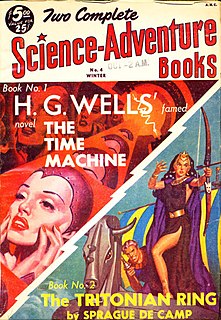
The Tritonian Ring is a heroic fantasy novel written by L. Sprague de Camp as part of his Pusadian series. It was first published in the magazine Two Complete Science Adventure Books for Winter, 1951, and first appeared in book form in de Camp's collection The Tritonian Ring and Other Pusadian Tales. Its first publication as a stand-alone novel was as a paperback by Paperback Library in 1968; the first hardcover edition was from Owlswick Press in 1977. An E-book edition was published as The Tritonian Ring and Other Pasudian [sic] Tales by Gollancz's SF Gateway imprint on September 29, 2011 as part of a general release of de Camp's works in electronic form.

"The Wheels of If" is an alternate history science fiction story by American writer L. Sprague de Camp. It was first published in the magazine Unknown Fantasy Fiction for October, 1940, and first appeared in book form in de Camp's collection The Wheels of If and Other Science Fiction. It later appeared in the paperback edition of the collection published by Berkley Books in 1970, in de Camp's subsequent collections The Virgin & the Wheels and Years in the Making: the Time-Travel Stories of L. Sprague de Camp, and in the anthology Unknown Worlds: Tales from Beyond. It also appeared, together with a sequel by Harry Turtledove, in The Pugnacious Peacemaker/The Wheels of If and Down in the Bottomlands and Other Places. The story has also been translated into German.

"The Animal-Cracker Plot" is a science fiction short story by American writer L. Sprague de Camp, a story in his Viagens Interplanetarias series. It is the second (chronologically) set on the planet Vishnu, and the first to feature the interstellar con-man Darius Koshay. It was first published in the magazine Astounding Science-Fiction in the issue for July, 1949. It first appeared in book form in the collection The Continent Makers and Other Tales of the Viagens, published in hardcover by Twayne Publishers in 1953, and in paperback by Signet Books in 1971. The story has been translated into Portuguese, Dutch, and Italian.

"The Galton Whistle" is a science fiction short story by American writer L. Sprague de Camp, a story in his Viagens Interplanetarias series. It is the first (chronologically) set on the planet Vishnu. It was first published, as "Ultrasonic God," in the magazine Future Combined with Science Fiction Stories in the issue for July, 1951. It first appeared in book form under the present title in the collection The Continent Makers and Other Tales of the Viagens, published in hardcover by Twayne Publishers in 1953, and in paperback by Signet Books in 1971. It also appeared in the anthologies Novelets of Science Fiction, The Good Old Stuff, and The Good Stuff. The story has been translated into Portuguese, Dutch, and Italian.

"Judgment Day" is an apocalyptic science fiction story by American writer L. Sprague de Camp. It was first published in the magazine Astounding Science Fiction for August, 1955, and first appeared in book form in the anthology The Best Science Fiction Stories and Novels: 1956. It later appeared in the de Camp collections A Gun for Dinosaur and Other Imaginative Tales, and The Best of L. Sprague de Camp, as well as the anthologies Great Science-Fiction, A Science Fiction Argosy, and Masters of Darkness III. The story has also been translated into German.

"Divide and Rule" is a science fiction novella by American writer L. Sprague de Camp. It was first published as a serial in the magazine Unknown from April to May, 1939 and first appeared in book form in de Camp's collection Divide and Rule. The story was revised for book publication. The first stand-alone book edition of the story was published as a large-print hardcover by Thorndike Press in September 2003. An E-book edition of the story was issued by Gollancz's SF Gateway imprint on September 29, 2011 as part of a general release of de Camp's works in electronic form.

"The Stolen Dormouse" is a science fiction novella by American writer L. Sprague de Camp. It was first published as a serial in the magazine Astounding Science-Fiction for April and May, 1941 and first appeared in book form in de Camp's collection Divide and Rule. The story has also appeared in the anthologies Astounding Stories: The 60th Anniversary Collection, and The Best of Astounding: Classic Short Novels from the Golden Age of Science Fiction.
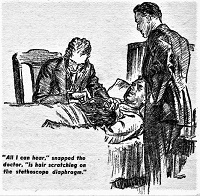
"Hyperpilosity" is a science fiction story by American writer L. Sprague de Camp. It was first published in the magazine Astounding Stories for April, 1938, and first appeared in book form in the de Camp collection The Wheels of If and Other Science Fiction (Shasta, 1949; It later appeared in the anthologies Omnibus of Science Fiction, Science Fiction of the Thirties, The Edward De Bono Science Fiction Collection, and The Road to Science Fiction #2: From Wells to Heinlein, as well as the magazine Fantastic Story Magazine and the de Camp collection The Best of L. Sprague de Camp. In 2014 the story was shortlisted for the Retro Hugo Award for Best Short Story.

"Living Fossil" is a science fiction story by American writer L. Sprague de Camp, on the concepts of human extinction and future evolution. It was first published in the magazine Astounding Science-Fiction for February 1939. It first appeared in book form in the anthology A Treasury of Science Fiction ; it later appeared in the anthologies Gates to Tomorrow, and The SFWA Grand Masters, Volume 1. The story has been translated into Danish, Swedish and Italian.

"The Blue Giraffe" is a science fiction story on the concept of mutation by American writer L. Sprague de Camp. It was first published in the magazine Astounding Science-Fiction for August, 1939. It first appeared in book form in the anthology Adventures in Time and Space ; it later appeared in the anthologies World of Wonder, The Science Fiction Bestiary, Androids, Time Machines and Blue Giraffes, Isaac Asimov Presents the Great Science Fiction Stories: Volume 1, 1939, Isaac Asimov Presents The Golden Years of Science Fiction, and An Anthropomorphic Century. The story has been translated into Italian, French and German.
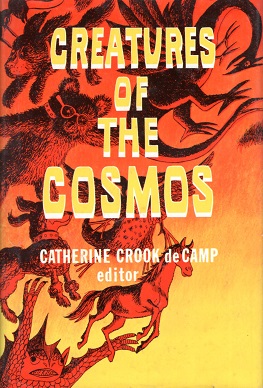
Creatures of the Cosmos is an anthology of fantasy and science fiction short stories for younger readers, edited by Catherine Crook de Camp. It was first published in hardcover by Westminster Press in 1977. It was the third such anthology assembled by de Camp, following the earlier 3000 Years of Fantasy and Science Fiction (1972) and Tales Beyond Time (1973), both of which she edited together with her husband L. Sprague de Camp.
